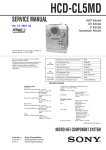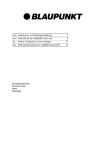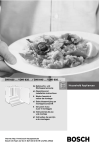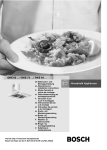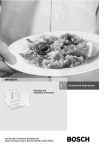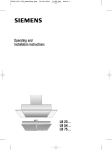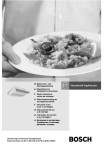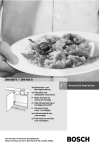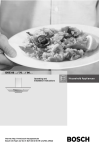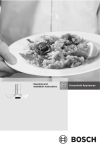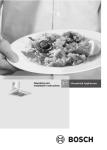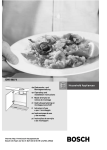Download Bosch DHI 625 M AU Operating instructions
Transcript
DHI 625 M AU Operating and installation instructions Internet: http://www.bosch-hausgeraete.de Bosch Info-Team: de Tel. 01 80/5 30 40 50 (E 0,12/Min. DTAG) a Fig. 1 GAZ min. 650 2 Abb. 1 ELECTR. min. 430 Instructions for use: Operating modes Appliance description Wall cupboard Filter frame Ventilator switches Pull-out vapour extractor Light switch Operating modes Exhaust-air mode: ❑ The extractor-hood fan extracts the kitchen vapours and conveys them through the grease filter into the atmosphere. ❑ The grease filter absorbs the solid particles in the kitchen vapours. ❑ The kitchen is kept almost free of grease and odours. D When the extractor hood is operated in exhaust-air mode simultaneously with a different burner which also makes use of the same chimney (such as gas, oil or coal-fired heaters, continuous-flow heaters, hot-water boilers) care must be taken to ensure that there is an adequate supply of fresh air which will be needed by the burner for combustion. Safe operation is possible provided that the underpressure in the room where the burner is installed does not exceed 4 Pa (0.04 mbar). This can be achieved if combustion air can flow through non-lockable openings, e.g. in doors, windows and via the airintake/exhaust-air wall box or by other technical measures, such as reciprocal interlocking, etc. If the air intake is inadequate, there is a risk of poisoning from combustion gases which are drawn back into the room. An air-intake/exhaust-air wall box by itself is no guarantee that the limiting value will not be exceeded. Note: When assessing the overall requirement, the combined ventilation system for the entire household must be taken into consideration. This rule does not apply to the use of cooking appliances, such as hobs and ovens. Unrestricted operation is possible if the extractor hood is used in recirculating mode – with activated carbon filter. Circulating-air mode: ❑ An activated carbon filter must be fitted for this operating mode (see Filters and maintenance). The complete installation set and replacement filters can be obtained from specialist outlets. The corresponding accessory numbers can be found at the end of these operating instructions. ❑ The extractor-hood fan extracts the kitchen vapours which are purified in the grease filter and activated carbon filter and then conveyed back into the kitchen. ❑ The grease filter absorbs the grease particles in the kitchen vapours. ❑ The activated carbon filter binds the odorous substances. If no activated carbon filter is installed, it is not possible to bind the odorous substances in the cooking vapours. 3 Before using for the first time Important notes: ❑ The Instructions for Use apply to several versions of this appliance. Accordingly, you may find descriptions of individual features that do not apply to your specific appliance. ❑ This extractor hood complies with all relevant safety regulations. Repairs should be carried out by qualified technicians only. Improper repairs may put the user at considerable risk. ❑ Before using your appliance for the first time, please read these Instructions for Use carefully. They contain important information concerning your personal safety as well as on use and care of the appliance. ❑ Please retain the operating and installation instructions for a subsequent owner. Do not use the appliance if damaged. The appliance is not intended for use Do not flambé food directly under the by young children or infirmed persons without supervision. Young children should be supervised to ensure they do not play with the appliance. If the connecting cable for this appliance is damaged, the cable must be replaced by the manufacturer or his customer service or a similarly qualified person in order to prevent serious injury to the user. The appliance may be connected to the mains by a qualified technician only. Dispose of packaging materials properly (see Installation instructions). This extractor hood is designed for domestic use only. Light bulbs must always be fitted when the extractor hood is in use. Defective bulbs should be replaced immediately to prevent the remaining bulbs from overloading. Never operate the extractor hood without a grease filter. Overheated fat or oil can easily catch fire. If you are cooking with fat or oil, e.g. chips, etc., never leave the cooker unattended. 4 extractor hood. Risk of grease filter catching fire due to flames. ! The hotplates must always be covered with a utensil. Restrictions apply to the use of the extractor hood over a solid-fuel burner (coal, wood, etc.). (See Installation instructions). Gas hobs / Gas cookers Do not use all the gas hotplates simultaneously for a prolonged period (max. 15 minutes) at maximum thermal load, otherwise there is a risk of burns if the housing surfaces are touched or a risk of damage to the extractor hood. If the extractor hood is situated over a gas hob, operate the hood at maximum setting if three or more gas hotplates are operated simultaneously. How to operate the extractor hood The most effective method of removing vapours produced during cooking is to: ❑ Switch the ventilator ON as soon as you begin cooking. ❑ Switch the ventilator OFF a few minutes after you have finished cooking. Switching the ventilator ON: 1. Pull out the vapour extractor tray. ❑ The ventilator is operating. 2. Select the required ventilator power level. Operating controls on different models: 1 2 Light: 0 OFF ON Note: The light can be switched on at any time, including when the vapour extractor tray has been pushed back into the hood. Level 1 Level 2 Level 1 2 Level 2 2 If you encounter a problem Level 3 2 3 1 2 3 Level 3 If you have any questions or if a fault occurs, please call Customer Service. (See list of Customer Service representatives). When you call, please quote the following: Level 1 Level 2 Switching the ventilator OFF: ❑ Push the vapour extractor tray back in as far as it will go. Note: The next time that the tray is pulled out, the ventilator will start up at the power level to which it was last set. E-Nr. FD Enter the relevant numbers into the box above. The E-Nr. (product no.) and FD (production date) are shown on the nameplate which can be seen inside the extractor hood after the filter frame has been detached. 5 Filters and maintenance Various types of grease filter can be used to absorb the grease contained in the vapours produced during cooking. The filter frame must be detached before the grease filter can be renewed. Detaching and re-attaching the filter frame: Detaching the frame: 1. Open the cupboard door. 2. Place your fingers in the recessed grips in the inspection window, push the filter frame towards the front and then pull it all the way out. 2. 1. Re-attaching the frame: 1. Insert the filter frame into the housing and push it in as far as it will go. 2. Close the cupboard door. Fleece grease filter: The filter mat is made from material that is itself virtually non-inflammable. Caution: As it becomes more and more saturated with grease however, the filter becomes increasingly inflammable. The efficiency of the extractor hood can also be adversely affected. Important: Renewing the fleece filter at appropriate intervals prevents the possibility of it catching fire as a result of a build-up of heat, such as occurs when deep-fat frying or roasting is taking place. 6 Renewing the fleece filter: ❑ Under normal operating conditions (1 to 2 hours per day), the fleece filter will require replacing after 8 to 10 weeks. ❑ Printed fleece filters must be renewed no later than when the coloured printing has started to fade. ❑ Use only original replacement filters. In so doing you will ensure that safety regulations are upheld and the extractor hood performs as effectively as possible. Removing/inserting the fleece filter: 1. Remove the wire frame. 2. Exchange the fleece filter. 3. Refit the wire frame. Metal grease filter: The filter mat is made of non-combustible metal. Caution: As it becomes more and more saturated with grease, the filter also becomes increasingly inflammable. The efficiency of the extractor hood can also be adversely affected. Important: By cleaning the metal grease filters at appropriate intervals, the possibility of them catching fire as a result of a build-up of heat such as occurs when deep-fat frying or roasting is taking place, is reduced. Cleaning the metal filter: Under normal operating conditions (1 to 2 hours per day), the metal grease filter will require cleaning after 8 to 10 weeks. Filters and maintenance ❑ The filter can be cleaned in a dishwasher. This can however cause slight discoloration. Important: Metal filters that are heavily saturated with grease should not be cleaned at the same time as any crockery, etc. ❑ If the filter mat is going to be cleaned by hand, soak it first of all in a hot detergent solution for several hours. Clean the filter with a brush, rinse it off thoroughly and allow it to drip dry. ❑ Use only original replacement filters. In so doing you will be ensuring that the extractor hood performs as effectively as possible. Removing/inserting the metal grease filter: See details for removing/inserting the fleece filter. Activated carbon filter: For neutralising odours when hood is used in recirculating-air mode. The activated carbon filter is installed above the grease filter inside the extractor hood. Inserting/removing the filter: 1. Remove the filter frame (see details on previous page). 2. Place wing nut and sleeve over screw, insert into housing and tighten firmly (applies only when installing filter for first time). 3. Hook the activated carbon filter into the left-hand side of the extractor hood housing, push the other side upwards and secure in place with the wing nut. 4. Re-attach the filter frame. To remove the activated carbon filter, proceed in reverse order. Renewing the activated carbon filter: Under normal operating conditions (1 to 2 hours per day), the activated carbon filter will require replacing approximately once per year. Replacement filters can be obtained from specialist retailers (see Optional accessories). ❑ Use only original replacement filters. In so doing you will be ensuring that the extractor hood performs as effectively as possible. Disposing of the old activated carbon filter: ❑ Activated carbon filters do not contain any pollutants and can be disposed of with domestic refuse. – Screw, sleeve and wing nut are enclosed with the activated carbon filter –. 7 Cleaning and care Disconnect the extractor hood from the electricity supply by pulling out the mains plug or switching it off at the fuse box. ❑ At the same time as you clean the grease filters, clean off any grease from all accessible parts of the housing. This significantly reduces the fire hazard and ensures that the extractor hood performs as effectively as possible. ❑ Use a hot detergent solution or a mild window cleaner to clean the canopy of the extractor hood. ❑ Do not scrape off any dirt that has dried on but loosen it up with a damp cloth. ❑ Do not use abrasive cleaning agents or sponges that could cause scratches. ❑ Note: Do not use alcohol (spirit) on plastic parts, otherwise the surface may become matt in appearance. Caution: Ensure that the kitchen is adequately ventilated. Avoid naked flames! Clean the operating buttons with a mild soapy solution and a soft, damp cloth only. Do not use stainless-steel cleaner to clean the operating buttons. Stainless steel surfaces: ❑ Use a mild non-abrasive stainless steel cleaner. ❑ Clean the surface in the same direction as it has been ground and polished. Do not use any of the following to clean stainless steel surfaces: abrasive sponges, cleaning agents containing sand, soda, acid or chloride! Aluminium, painted and plastic surfaces: ❑ Use a soft, non-linting window cloth or micro-fibre cloth. ❑ Do not use dry cloths. ❑ Use a mild window cleaning agent. ❑ Do not use aggressive, acidic or caustic cleaners. ❑ Do not use abrasive agents. 8 For appliances with a glass plate in the pull-out vapour extractor: ❑ The glass plate is easily removed and can be cleaned in a dishwasher. ❑ To remove the lugs, push outwards. Replacing the light bulb 1. Switch off the extractor hood and pull out the mains plug or switch off the electricity supply at the fuse box. 2. Pull out the extractor hood and detach the filter frame. 3. Replace the bulb (standard filament bulb, max 40 W, E14 bulb holder). 4. Re-attach the filter frame. 5. Plug appliance into mains again or switch on at the fuse box. Installation Instructions: Important information Old appliances are not worthless rubbish. Valuable raw materials can be reclaimed by recycling old appliances. Before disposing of your old appliance, render it unusable. You received your new appliance in a protective shipping carton. All packaging materials are environmentally friendly and recyclable. Please contribute to a better environment by disposing of packaging materials in an environmentally-friendly manner. Please ask your dealer or inquire at your local authority about current means of disposal. The extractor hood can be used in exhaust air or circulating air mode. Always mount the extractor hood over Additional information concerning gas cookers: When installing gas hotplates, comply with the relevant national statutory regulations (e.g. in Germany: Technische Regeln Gasinstallation TRGI). Always comply with the currently valid regulations and installation instructions supplied by the gas appliance manufacturer. Only one side of the extractor hood may be installed next to a high-sided unit or high wall. Gap at least 50 mm. Minimum distance on gas hotplates between the upper edge of the trivet and lower edge of the extractor hood: 650 mm, Fig. 1. the centre of the hob. Minimum distance between electric hob and bottom edge of extractor hood: 430 mm, Fig. 1. The extractor hood must not be installed over a solid fuel cooker – a potential fire hazard (e.g. flying sparks) – unless the cooker features a closed, non-removable cover and all national regulations are observed. The smaller the gap between the extractor hood and hotplates, the greater the likelihood that droplets will form on the underside of the extractor hood. 9 Prior to installation Exhaust-air mode 100 120 The exhaust air is discharged upwards through a ventilation shaft or directly through the outside wall into the open. D Exhaust air must not be discharged via a smoke or exhaust gas flue which is already in use or via a shaft which is used for ventilating rooms in which fireplaces are located. Discharge exhaust air in accordance with official and statutory regulations (e.g. national building regulations). Discharge of air into smoke or exhaust air flues which are not in use requires the consent of a heating engineer. D If the extractor hood is operated in exhaust-air mode at the same time as a flue-type heater (e.g. gas, oil or solid-fuel heater, instantaneous water heater, boiler), ensure that there is an adequate air supply which the heater requires for combustion. Safe operation is possible provided that the partial vacuum in the room in which the heater is installed does not exceed 4 Pa (0.04 mbar). 10 100 120 100 120 This can be achieved if the combustion air is able to flow through non-lockable openings, e.g. in doors, windows and in conjunction with an air supply/air-intake wall box or by other technical procedures such as reciprocal interlocking. If the air intake is inadequate, there is a risk of poisoning from combustion gases which are drawn back into the room. An air-intake/exhaust-air wall box by itself is no guarantee that the limiting value will not be exceeded. Note: When assessing the overall requirement, the combined ventilation system for the entire household must be taken into consideration. This rule does not apply to the use of cooking appliances, such as hobs and gas cookers. The extractor hood can be used without restriction in circulating air mode – with an activated carbon filter. For exhaust air mode a one-way flap should be installed in the extractor hood unless already installed in the exhaust air pipe or wall box. If a one-way flap is not enclosed with the extractor hood, you purchase one from your dealer. If the exhaust air is conveyed through the outside wall, a telescopic wall box should be used. Prior to installation Exhaust outlet connection: Pipe diameter: 100 or 120 mm. ❑ Insert the enclosed outlet connector and twist it as far as it will go. ❑ If the pipe diameter is 120 mm, cut out the inner part of the outlet connector. Exhaust air flows upwards: ❑ Cut a hole in the top of the wall cupboard, including a groove for the mains cable. – Template O I lis enclosed –. 115/130 125 200 120 100 0 18 75 25 212 32 28 25 0 9 6 00 80 542 500 20 196 40 7 40 0 ,5 45 61 m 28 in. 0 For optimum extractor hood efficiency: ❑ Short, smooth air exhaust pipe. ❑ As few bends in the pipe as possible. ❑ Diameter of pipe to be as large as possible (ideal is l 120 mm ) and no tight bends in pipe. If long, rough exhaust-air pipes, many pipe bends or smaller pipe diameters are used, the air extraction rate will no longer be at an optimum level and there will be an increase in noise. ❑ Round pipes: We recommend Internal diameter at least. 120 mm. ❑ Flact ducts must have an internal cross-section that equates to that of round pipes with a 100/120 mm internal diameter. There should be no sharp bends. l 100 mm approx. 078 cm2 l 120 mm approx. 113 cm2 If pipes have different diameters: ❑ Insert sealing strip. ❑ For exhaust-air mode, ensure that there is an adequate supply of fresh air. 5 98 Exhaust flows straight out at the back: – inside the wall cupboard –. ❑ Cut a hole in the rear panel of the wall cupboard, including a groove for the mains cable. Circulating-air mode ❑ With activated carbon filter if exhaust-air mode is not possible. The complete installation set can be obtained from specialist outlets. The corresponding accessory numbers can be found at the end of these operating instructions. Preparation: ❑ Cut a hole in the top of the wall cupboard, including a groove for the mains cable. – Template O I is enclosed –. 11 Preparing the wall cupboard Ensure that there is a minimum gap between hob and extractor hood of 650 mm (for gas hobs) or 430 mm (for electric hobs). This extractor hood has been designed for installation inside a wall cupboard with the following dimensions: Width: 600 mm Depth: 280 bis 350 mm Height:at least 280 mm. Preparation: 1. Remove bottom panel of cupboard – if fitted. The stability of the cupboard must be maintained. 2. Mark two points – right and left – on the inside of the cupboard where the hood is to be mounted, and start the hole with a gimlet. Details for drilling: l 2 mm – max. 10 mm deep. II for marking Use enclosed template O points where hood is to be mounted. Caution: ❑ The mounting points shown on the template have been configured in such a way as to allow a 20 mm thick handle to be attached flush with the front edges of the cupboard. ❑ If no handle is going to be attached, the mounting points must be brought forward by 20 mm. If the cupboard depth is greater than 280 mm, the hood can be mounted further back, . . . if the light strip under the cupboard . . . units is mounted further back, . . . if the handle is more than 20 mm thick. 12 To do this, move the mounting points further towards the back by the corresponding distance. 3. Align the 4 enclosed mounting brackets and screw them on tight. Installation inside the wall cupboard 1. Align the cupboard doors if the hinges will no longer be accessible after the extractor hood has been fitted. 2. Place the extractor hood onto the mounting brackets and push it into the cupboard. 4. Install a shelf immediately above the extractor hood. Cut holes for the pipe connection and the mains cable. 20 Important: The extractor hood must be firmly seated on the 4 mounting brackets. 3. Loosely screw in the 4 enclosed screws. Align the extractor hood and then tighten screws. Check that the extractor hood is firmly fitted into the cupboard. mind.15 20 75 mind. 4 If the shelf is permanently fixed inside the cupboard, 4 holes must be drilled to provide access to the 4 mounting screws for the extractor hood. 5. Route the mains cable through the hole in the wall cupboard and connect up the exhaust pipe. 6. Connect up the extractor hood to the mains. 7. If no handle is going to be attached to the vapour extractor, seal off the 3 holes with the enclosed caps. 13 Installation inside the wall cupboard 8. Cut the wall masking strip down to size if necessary and screw it onto the wall cupboard. Attaching a handle to the vapour extractor: ❑ A handle can be attached to the vapour extractor. ❑ This handle can either be a wooden strip that matches the kitchen cupboards or a the handle that is available as an optional accessory (see section on optional accessories in the user instructions). III to mark 1. Use the enclosed template O the 3 mounting points on the handle and start the hole with a gimlet. Details for drilling: l 2 mm – max. 10 mm deep. 598 94 230 44 230 20 2. Align handle and attach it to the extractor with the 3 enclosed screws. 14 Installation inside the wall cupboard Note: The extractor hood housing inside the wall cupboard can be boarded up (e.g. with chipboard). Please observe the following: – The shelf must not be rest upon the extractor hood housing. – The board at the front should not be attached to the housing. – Ensure that access is possible for replacing filters or by Customer Service. Weight in kg: Exhaust air Re-circulating air 7,0 8,0 The manufacturer reserves the right to make design alterations in the interests of technical development. Electrical connection WARNING: THIS APPLIANCE MUST BE EARTHED IMPORTANT: Fitting a Different Plug: The wires in the mains lead are coloured in accordance with the following code: Green and Yellow – Earth Blue – Neutral Brown – Live If you fit your own plug, the colours of these wires may not correspond with the identifying marks on the plug terminals. This is what you have to do: 1. Connect the green and yellow (Earth) wire to the terminal in the plug marked ‘E’ or with the symbol ( ), or coloured green or green and yellow. 2. Connect the blue (Neutral) wire to the terminal in the plug marked ‘N’ or coloured black. 3. Connect the brown (Live) wire to the terminal marked ‘L’, or coloured red. The extractor hood may only be connected to an earthed socket that has been installed according to the relevant regulations. If possible, site the earthed socket directly above the wall cupboard or in its immediate vicinity. Electrical specifications: Are to be found on the name plate inside the appliance after removal of the filter frame. Before undertaking any repairs, always disconnect the extractor hood from the electricity supply. Length of the connecting cable: 1,30 m. If it is necessary to wire the extractor hood directly into the mains: The extractor hood may only be connected up by a qualified electrician approved by the appropriate electricity company. A separator must be installed in the household circuit. A suitable separator is a switch that has a contact gap of more than 3 mm and interrupts all poles. Such devices include circuit breakers and contactors. This extractor hood complies with EC regulations relating to the suppression of RF interference. 15 DHZ 2100 DHZ 3200 2 1 3 DHZ 3105 4 5 3x 6 299600 1. 2. 3. DHZ 3350 084848 Robert Bosch Hausgeräte GmbH 9000 021 954 Printed in Germany 0804 Es.
















